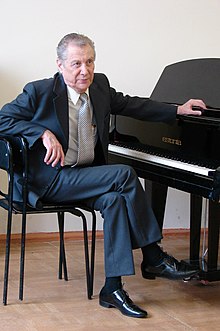
Summary
Andrei Yakovlevich Eshpai (Russian: Андре́й Я́ковлевич Эшпа́й; 15 May 1925 – 8 November 2015) was a Soviet and Russian composer.[1] He was awarded the title of People's Artist of the USSR in 1981.
Andrei Eshpai | |
|---|---|
Андрей Эшпай | |
 | |
| Born | 15 May 1925 |
| Died | 8 November 2015 (aged 90) |
| Era | 20th century |
| Children | Andrei Andreyevich Eshpai |
| Parent | Yakov Andreyevich Eshpai |
Biography edit
Eshpai was born at Kozmodemyansk, Mari ASSR, Russian SFSR to a Mari father and Russian mother.[2][3] A Red Army World War II veteran, he studied piano at Moscow Conservatory from 1948 to 1953 under Vladimir Sofronitsky, and composition under Nikolai Rakov, Nikolai Myaskovsky and Evgeny Golubev. He performed his postgraduate study under Aram Khachaturian from 1953 to 1956.[4]
Eshpai was the son of the composer Yakov Eshpai, and the father of the filmmaker Andrei Andreyevich Eshpai.[5]
On 8 November 2015, Eshpai died in Moscow from a stroke at the age of 90.[6]
Notable works edit
Stage edit
- Nobody Is Happier Than Me, operetta (1968–1969); libretto by V. Konstantinov and B. Ratser
- Love Is Forbidden, musical (1973)
- Angara, ballet (1974–1975)
- A Circle, ballet (1979–1980)
Orchestral edit
- Symphonic Dances on Mari Themes (1951)
- Symphony no. 1 in E♭ minor (1959)
- Symphony no. 2 in A major "Praise the Light" (1962)
- Symphony no. 3 (1964)
- Symphony no. 4 "Symphony-Ballet" (1980-1981)
- Simon Bolivar, Symphonic Poem (1982)
- Symphony No. 5 (1985)
- Symphony No. 6 "Liturgic" for mixed chorus, baritone (or bass) and symphony orchestra (1988)
- Symphony No. 7 (1991)
- Games (1997)
- Symphony No. 8 (2000–2001)
- Symphony No. 9 "Four Verses" for symphony orchestra, mixed chorus and narrators (1998–1999)
Concertante edit
- Piano Concerto No. 1 in F♯ minor (1954)
- Violin Concerto No. 1 in G minor (1956)
- Concerto Grosso, Concerto for orchestra with solo trumpet, piano, vibraphone and double bass (1966–1967)
- Piano Concerto No. 2 (1972)
- Violin Concerto No. 2 (1977)
- Viola Concerto (1987)
- Cello Concerto (1989)
- Clarinet Concerto (1995)
- Flute Concerto (1992)[7]
- Violin Concerto No. 3 "Bartok Concerto" (1990–1992)
- Violin Concerto No. 4 (1993)[8]
- Oboe Concerto (1982)
- Concerto for trumpet, trombone and orchestra (1994–1995)
- Double Bass Concerto (1994–1995)
- Horn Concerto in F major (1995)
- Tuba Concerto (2001)
- Bassoon Concerto Opus Singularis (2001)
Other edit
- 3 violin sonatas
- piano compositions
- songs
References edit
- ^ Don Michael Randel (1996). The Harvard Biographical Dictionary of Music. Harvard University Press. pp. 252–. ISBN 978-0-674-37299-3. Retrieved 7 July 2013.
- ^ Российская газета
- ^ Joel Flegler (1995). Fanfare. J. Flegler. p. 167.
- ^ Maurice Hinson (1993). Music for Piano and Orchestra: An Annotated Guide. Indiana University Press. p. 90. ISBN 978-0-253-33953-9.
- ^ Soviet Film. Sovexportfilm. 1973. p. 36.
- ^ Композитор Андрей Эшпай скончался в Москве на 91-м году жизни (in Russian). TASS. 8 November 2015. Retrieved 8 November 2015.
- ^ "Eshpai Vol3 Concerto flute & Orch etc. [RB]: Classical CD Reviews – July 2003 MusicWeb(UK)". Retrieved 7 July 2013.
- ^ "ANDREI ESHPAI (1925–) Vol. 1 : Classical CD Reviews – Oct 1999". Retrieved 7 July 2013.
External links edit
- Eshpai at Onno van Rijen's site
- Eshpai at Peoples (in Russian)


